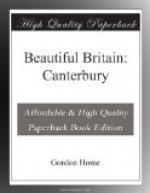During the year following the Norman Conquest a fire began in Canterbury, which, besides destroying many houses, reduced the unfortunate cathedral to a roofless ruin once more. Three years later, in 1070, when Lanfranc was made the first Norman archbishop, he decided that the Saxon walls were worthless, and he swept away every trace of the building, which may have been partially Roman, before proceeding to erect a larger and grander pile in the Norman style familiar to him. One feature of the original church has, nevertheless, left its mark on the Norman cathedral. This was a crypt described by Eadmer, the monkish historian, who, as a boy, saw the Saxon church being demolished. It was only a small affair, but it must have been the most remarkable feature of the comparatively small oblong building, for it was not, properly speaking, a crypt at all, but an undercroft beneath the eastern altars. “To reach these altars,” says Eadmer, “a certain crypt, which the Romans call a confessionary, had to be ascended by means of several steps from the choir of the singers. Thus the Norman archbishop, in planning a larger cathedral, constructed a crypt under the choir of his new building, and the steps one ascends to-day are there as the direct outcome of the structural methods of rude Saxon times.”
Lanfranc completed his new cathedral in 1077, and in his lifetime he also founded the great Benedictine priory of Christ Church, whose considerable remains add so much medievalism to the surroundings of the vast cathedral. Anselm succeeded Lanfranc after an interval of a few years, during which Rufus found it exceedingly desirable to keep the see vacant while the revenues were diverted into the royal coffers, and scarcely twenty years after his predecessor’s church was finished, Prior Ernulph pulled down the east end and constructed in its place the magnificent Norman choir, with its transepts and chapels standing with various alterations to-day. This great work was finished by Prior Conrad, who succeeded Ernulph, and the noble work, which became known as Conrad’s Choir, was consecrated in 1130 by Archbishop de Corbeuil. To make this bald statement and omit to mention the ceremony attending it would be misleading; for not only were Henry I. and David of Scotland present, but Canterbury saw such a gathering of dignitaries of Church and State with their splendid retinues that the historian found nothing to compare with it but Solomon’s dedication of the Temple!
This splendid church, representing the finest achievement of Norman master-builders and workmen, rising high above the domestic quarters of the monastery and standing forth conspicuously from every part of the little walled city, then consisting, to a considerable extent, of low wooden houses, had now reached the stage in its development when it was to be the scene of the murder which was to make Canterbury the most famous resort of pilgrims in Europe. This occurred forty years later; but no change in the great Norman church had taken place in that period.




